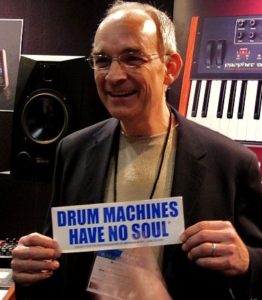 Electronics gave musicians the opportunity to experiment outside the confines of the traditional four or five piece live band.
Electronics gave musicians the opportunity to experiment outside the confines of the traditional four or five piece live band.
Synthesizers meant to an extent that ensembles of instruments could be replaced and led to the formation of more streamlined combos who could exert a greater degree of artistic control.
And with the simultaneous advent of the drum machine, there came the elimination of the most unpredictable element of any band… the drummer! With one of these electronic units, precise and metronomic rhythm could be provided without the annoying desire of a human to egotistically add fills or breaks!
Hence came the joke: “What is the difference between a drummer and a drum machine? With a drum machine, you only have to punch the instructions in once!”
However, if a drummer was willing to join in on the minimal electronic adventure, an array of hand triggered synthetic devices could be used to replace parts of the conventional drum kit while syncopating along to a precise machine rhythm. KRAFTWERK’s Wolfgang Flür was one of the first musicians to be widely seen playing a self-built electronic percussion set on German TV Station ZDF in 1973.
He said in his autobiography ‘I Was A Robot’: “It’s the eternal dilemma of percussionists in many bands I’ve seen, who like to see themselves as the dominant artists and therefore play those wearing, extravagant drum solos…”.
So here are the drum machines and electronic percussion sets that ELECTRICITYCLUB.CO.UK has the most affection for. As with TEC’s 25 Favourite Vintage Synthesizers list, they are not necessarily the most technically accomplished of machines, but each have their place in electronic music history. This list is purely for fun and not a product endorsement, presented chronologically by year of production origin and then alphabetically.
But before ELECTRICITYCLUB.CO.UK proceeds with its list, here’s another joke: “How many drummers does it take to change a lightbulb? None, because there are machines that can do exactly what drummers do, and so much better!” 😉
KEIO MINIPOPS 7 (1967)
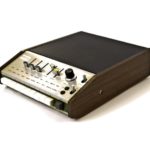 Made by Japanese company Keio who eventually morphed into Korg, this rhythm unit had 2 banks of 10 rhythms which were selected by a flip switch. With its distinctive snakey guiro sound, although not credited, it appeared on JEAN MICHEL JARRE’s first two albums ‘Oxygène’ and ‘Equinoxe’. The mournful Factory act MINNY POPS derived their name from this machine while it was also used by BLANCMANGE on the ‘Some Bizzare Album’ version of ‘Sad Day’.
Made by Japanese company Keio who eventually morphed into Korg, this rhythm unit had 2 banks of 10 rhythms which were selected by a flip switch. With its distinctive snakey guiro sound, although not credited, it appeared on JEAN MICHEL JARRE’s first two albums ‘Oxygène’ and ‘Equinoxe’. The mournful Factory act MINNY POPS derived their name from this machine while it was also used by BLANCMANGE on the ‘Some Bizzare Album’ version of ‘Sad Day’.
Iconic Example Of Use: JEAN MICHEL JARRE ‘Equinoxe V’
ELKA DRUMMER ONE (1969)
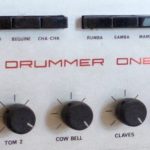 Looking a bit like a Hi-Fi Receiver, this simple preset rhythm box from the Italian organ manufacturer was much loved by kosmische bands such as CLUSTER and HARMONIA. It was one of the first machines to have individual volume level control for each of its 9 percussion sounds and by pressing two separate preset rhythm buttons, a whole new pattern could be generated. The limitations of such devices often led musicians to making other worldly music with these source sounds.
Looking a bit like a Hi-Fi Receiver, this simple preset rhythm box from the Italian organ manufacturer was much loved by kosmische bands such as CLUSTER and HARMONIA. It was one of the first machines to have individual volume level control for each of its 9 percussion sounds and by pressing two separate preset rhythm buttons, a whole new pattern could be generated. The limitations of such devices often led musicians to making other worldly music with these source sounds.
Iconic Example Of Use: HARMONIA ‘Dino’
FARFISA RHYTHM UNIT 10 (1969)
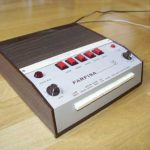 An early preset drum machine designed as a home organ accompaniment, this was the first such unit owned by Ralf Hütter and Florian Schneider who used it on early KRAFTWERK recordings like the sub-17 minute ‘Kling Klang’ and the studio take of ‘Tanzmusik’. While limited in its capability, the duo’s curiosity led to the unit being customised for their own ends so that the sounds could be hand triggered, and thus leading to the investigation of the electronic rhythms that KRAFTWERK were later to become famous for.
An early preset drum machine designed as a home organ accompaniment, this was the first such unit owned by Ralf Hütter and Florian Schneider who used it on early KRAFTWERK recordings like the sub-17 minute ‘Kling Klang’ and the studio take of ‘Tanzmusik’. While limited in its capability, the duo’s curiosity led to the unit being customised for their own ends so that the sounds could be hand triggered, and thus leading to the investigation of the electronic rhythms that KRAFTWERK were later to become famous for.
Iconic Example Of Use: KRAFTWERK ‘Kling Klang’
EKO RHYTHMAKER (1972)
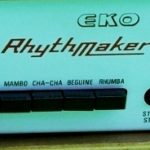 An Italian drum box that although wasn’t programmable, had separate fader controls for each of its sounds. It made a prominent appearance on ASHRA’s cult ambient classic ‘New Age Of Earth’. Will Sergeant from ECHO & THE BUNNYMEN also acquired one and named it ‘Echo’ after the manufacturer and inspiring the band name; it was used on their debut 45 ‘Pictures On My Wall’. ‘Echo’ was later replaced by a Doctor Rhythm DR55, but is believed to have ended up moonlighting on OMD’s debut album.
An Italian drum box that although wasn’t programmable, had separate fader controls for each of its sounds. It made a prominent appearance on ASHRA’s cult ambient classic ‘New Age Of Earth’. Will Sergeant from ECHO & THE BUNNYMEN also acquired one and named it ‘Echo’ after the manufacturer and inspiring the band name; it was used on their debut 45 ‘Pictures On My Wall’. ‘Echo’ was later replaced by a Doctor Rhythm DR55, but is believed to have ended up moonlighting on OMD’s debut album.
Iconic Example Of Use: OMD ‘Julia’s Song’
ROLAND TR77 (1972)
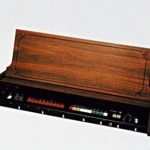 The first rhythm machine used by Warren Cann of ULTRAVOX, its debut appearance was on ‘Hiroshima Mon Amour’. Using a sub-bossa nova preset with buttons pushed in assorted combinations to achieve variation, it provided the spacey backbone to the chilling highlight of the ‘Ha! Ha! Ha!’ album. The ‘TR’ prefix stood for ‘Transistor Rhythm’. Critically, the TR77 had separate faders for the kick, snare, guiro, hi-hat, cymbal and maracas sounds, thereby making it a very flexible machine for use in the studio.
The first rhythm machine used by Warren Cann of ULTRAVOX, its debut appearance was on ‘Hiroshima Mon Amour’. Using a sub-bossa nova preset with buttons pushed in assorted combinations to achieve variation, it provided the spacey backbone to the chilling highlight of the ‘Ha! Ha! Ha!’ album. The ‘TR’ prefix stood for ‘Transistor Rhythm’. Critically, the TR77 had separate faders for the kick, snare, guiro, hi-hat, cymbal and maracas sounds, thereby making it a very flexible machine for use in the studio.
Iconic Example Of Use: ULTRAVOX ‘Hiroshima Mon Amour’
PAiA PROGRAMMABLE DRUM SET (1975)
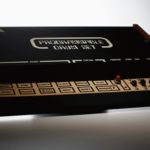 Often credited as the first programmable drum machine, sounds were produced using a technique called ringing oscillators. A filter that was very close to oscillating on its own was hit with a short pulse so that it rang the way a drum did! Designed in Oklahoma, it was sold as a kit with instructions for the buyer to build the machine themselves. PETER GABRIEL was one of its first exponents.
Often credited as the first programmable drum machine, sounds were produced using a technique called ringing oscillators. A filter that was very close to oscillating on its own was hit with a short pulse so that it rang the way a drum did! Designed in Oklahoma, it was sold as a kit with instructions for the buyer to build the machine themselves. PETER GABRIEL was one of its first exponents.
Iconic Example Of Use: PETER GABRIEL ‘Games Without Frontiers’
POLLARD SYNDRUM QUAD (1976)
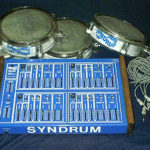 The first commercially available electronic drum was devised by Joe Pollard, a drummer who played with THE BEACH BOYS. Although the Syndrum had many different sounds, the one most commonly used was a sine wave that pitch-bent downwards… hence the ubiquitous and some would say annoying “doooo-oo” sound of the disco era! Despite the Syndrum being heard everywhere, Pollard had financial problems, leaving rivals Star and Simmons to take up the mantle for hand operated electronic percussion.
The first commercially available electronic drum was devised by Joe Pollard, a drummer who played with THE BEACH BOYS. Although the Syndrum had many different sounds, the one most commonly used was a sine wave that pitch-bent downwards… hence the ubiquitous and some would say annoying “doooo-oo” sound of the disco era! Despite the Syndrum being heard everywhere, Pollard had financial problems, leaving rivals Star and Simmons to take up the mantle for hand operated electronic percussion.
Iconic Example Of Use: THE CARS ‘Good Times Roll’
ROLAND CR78 COMPURHYTHM (1978)
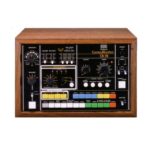 One of the most distinctive sounding drum machines ever made, it was the first device of its kind to use integrated circuits. The CR78 had an accent control knob which increased the loudness of certain steps, plus there were useful mute buttons for four of the sounds including bass and snare to give further variation while in operation. This programmable unit with 15 sounds and 34 different preset rhythms was used by most of the Synth Britannia innovators including GARY NUMAN, OMD, JOHN FOXX and ULTRAVOX.
One of the most distinctive sounding drum machines ever made, it was the first device of its kind to use integrated circuits. The CR78 had an accent control knob which increased the loudness of certain steps, plus there were useful mute buttons for four of the sounds including bass and snare to give further variation while in operation. This programmable unit with 15 sounds and 34 different preset rhythms was used by most of the Synth Britannia innovators including GARY NUMAN, OMD, JOHN FOXX and ULTRAVOX.
Iconic Example Of Use: OMD ‘Enola Gay’
STAR SYNARE 3 (1978)
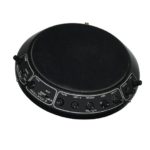 The earlier Synares 1 and 2 had several drum pads built into a suitcase, but the Synare 3 was a standalone drum synthesizer that looked like a flying saucer, triggered by hitting the pressure sensitive rubber pad. There was a noise generator with a tune function and a low-pass filter with cut-off, resonance and decay controls. It was used by Warren Cann for the thunder sound on ULTRAVOX’s ‘Vienna’ and Stephen Morris for the “tschak-tschak” noise on JOY DIVISION’s ‘She’s Lost Control’.
The earlier Synares 1 and 2 had several drum pads built into a suitcase, but the Synare 3 was a standalone drum synthesizer that looked like a flying saucer, triggered by hitting the pressure sensitive rubber pad. There was a noise generator with a tune function and a low-pass filter with cut-off, resonance and decay controls. It was used by Warren Cann for the thunder sound on ULTRAVOX’s ‘Vienna’ and Stephen Morris for the “tschak-tschak” noise on JOY DIVISION’s ‘She’s Lost Control’.
Iconic Example Of Use: ULTRAVOX ‘Vienna’
KORG RHYTHM 55 (1979)
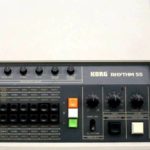 With 48 preset patterns with 16 intros / fill-ins and 10 drum voices, this was Daniel Miller’s first drum machine and used on his early productions such as ‘Lady Shave’ by FAD GADGET, ‘Memorabilia’ by SOFT CELL and DEPECHE MODE’s first recorded version of ‘Photographic’ for the ‘Some Bizzare Album’. The Korg Rhythm 55 had a characteristically klanky percussive sound which JEAN MICHEL JARRE also used as the metronomic bed for his third long player ‘Magnetic Fields’.
With 48 preset patterns with 16 intros / fill-ins and 10 drum voices, this was Daniel Miller’s first drum machine and used on his early productions such as ‘Lady Shave’ by FAD GADGET, ‘Memorabilia’ by SOFT CELL and DEPECHE MODE’s first recorded version of ‘Photographic’ for the ‘Some Bizzare Album’. The Korg Rhythm 55 had a characteristically klanky percussive sound which JEAN MICHEL JARRE also used as the metronomic bed for his third long player ‘Magnetic Fields’.
Iconic Example Of Use: DEPECHE MODE ‘Photographic (Some Bizzare Version)’
PEARL SYNCUSSION SY1 (1979)
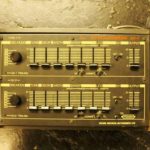 This was a two channel drum synth where each section had an oscillator that could produce different basic waveforms which were then shaped by a simple envelope generator. Usually triggered from two bongo-like drums fitted with transducers, it could also be activated via a synth with a gate output. It was extensively used by Mal Holmes for OMD’s crunchy electronic percussion sounds to replace conventional hi-hat and cymbals.
This was a two channel drum synth where each section had an oscillator that could produce different basic waveforms which were then shaped by a simple envelope generator. Usually triggered from two bongo-like drums fitted with transducers, it could also be activated via a synth with a gate output. It was extensively used by Mal Holmes for OMD’s crunchy electronic percussion sounds to replace conventional hi-hat and cymbals.
Iconic Example Of Use: OMD ‘Joan Of Arc’
BOSS DOCTOR RHYTHM DR55 (1980)
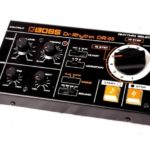 Not to be confused with the Korg Rhythm 55, this basic ‘step-write’ drum machine was produced by Roland’s musical accessory sub-division and one of the first truly affordable programmable drum machines. With just primitive analogue generated kick, snare, hi-hat and rimshot sounds available, it possessed a unique character of its own. Its successor, the DR110 featured a novel LCD rhythm pattern display and manual fill capability with sounds similar to the Roland TR606 Drumatix.
Not to be confused with the Korg Rhythm 55, this basic ‘step-write’ drum machine was produced by Roland’s musical accessory sub-division and one of the first truly affordable programmable drum machines. With just primitive analogue generated kick, snare, hi-hat and rimshot sounds available, it possessed a unique character of its own. Its successor, the DR110 featured a novel LCD rhythm pattern display and manual fill capability with sounds similar to the Roland TR606 Drumatix.
Iconic Example Of Use: NEW ORDER ‘Truth’
LINN LM-1 (1980)
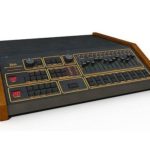 Using digital samples of real drum sounds, Roger Linn’s drum computer changed pop music with its logical programming capability. It gained prominence on THE HUMAN LEAGUE’s ‘Dare’ and HEAVEN 17’s ‘Penthouse & Pavement’. It was also used hand triggered by Steve Jansen for the clap and bass drum sounds on JAPAN’s ‘Tin Drum’. The first Linn did not actually have a crash cymbal sound because there was not enough memory in the chips. When it came out, it cost the same as a Renault 5!
Using digital samples of real drum sounds, Roger Linn’s drum computer changed pop music with its logical programming capability. It gained prominence on THE HUMAN LEAGUE’s ‘Dare’ and HEAVEN 17’s ‘Penthouse & Pavement’. It was also used hand triggered by Steve Jansen for the clap and bass drum sounds on JAPAN’s ‘Tin Drum’. The first Linn did not actually have a crash cymbal sound because there was not enough memory in the chips. When it came out, it cost the same as a Renault 5!
Iconic Example Of Use: THE HUMAN LEAGUE ‘Don’t You Want Me?’
ROLAND TR808 RHYTHM COMPOSER (1980)
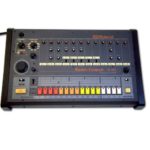 Probably one of the most popular analogue drum machines, it had distinctive sounds such as its handclap and bongos that while sounding nothing like what they were supposed to represent, possessed a unique character that appealed particularly within urban dance culture. First used on YELLOW MAGIC ORCHESTRA’s ‘BGM’ album in 1981, it was also used by SOFT CELL and YAZOO but gained prominence on a variety of Arthur Baker’s classic New York electro crossover productions with AFRIKA BAMBAATA.
Probably one of the most popular analogue drum machines, it had distinctive sounds such as its handclap and bongos that while sounding nothing like what they were supposed to represent, possessed a unique character that appealed particularly within urban dance culture. First used on YELLOW MAGIC ORCHESTRA’s ‘BGM’ album in 1981, it was also used by SOFT CELL and YAZOO but gained prominence on a variety of Arthur Baker’s classic New York electro crossover productions with AFRIKA BAMBAATA.
Iconic Example Of Use: AFRIKA BAMBAATA & THE SOUL SONIC FORCE ‘Planet Rock’
SOUND MASTER MEMORY RHYTHM SR88 (1980)
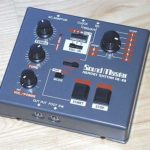 This was an entry level ‘step-write’ drum machine that was owned by ELECTRICITYCLUB.CO.UK! It provided hours of fun with just four really thin analogue drum sounds (kick / snare / hi-hat / cymbal) by tapping the keys like Morse Code!! It had a useful clock output for synching to basic sequencers while an output pulse could also be synched with the cymbal sound to trigger synths for more varied effects. It was the rhythm box that COCTEAU TWINS used when they first formed.
This was an entry level ‘step-write’ drum machine that was owned by ELECTRICITYCLUB.CO.UK! It provided hours of fun with just four really thin analogue drum sounds (kick / snare / hi-hat / cymbal) by tapping the keys like Morse Code!! It had a useful clock output for synching to basic sequencers while an output pulse could also be synched with the cymbal sound to trigger synths for more varied effects. It was the rhythm box that COCTEAU TWINS used when they first formed.
Iconic Example Of Use: CRY ‘Looking To The Future’
MOVEMENT SYSTEMS DRUM COMPUTER MKI (1981)
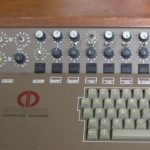 This was the British-built hybrid drum computer used by EURYTHMICS which appeared in their ‘Sweet Dreams (Are Made Of This)’ video. Its nine analogue synthesized drum sounds were similar to Simmons SDSV while the five digital ones were 8 bit samples. A monitor came separately to display the drum notes and sequencing graphically in a similar fashion to page R on the Fairlight CMI. The MKII had a built-in monitor and was used by THOMPSON TWINS, but was bulky when compared with the LinnDrum.
This was the British-built hybrid drum computer used by EURYTHMICS which appeared in their ‘Sweet Dreams (Are Made Of This)’ video. Its nine analogue synthesized drum sounds were similar to Simmons SDSV while the five digital ones were 8 bit samples. A monitor came separately to display the drum notes and sequencing graphically in a similar fashion to page R on the Fairlight CMI. The MKII had a built-in monitor and was used by THOMPSON TWINS, but was bulky when compared with the LinnDrum.
Iconic Example Of Use: EURYTHMICS ‘Sweet Dreams (Are Made Of This)’
OBERHEIM DMX (1981)
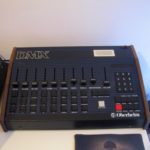 The digital drum machine on NEW ORDER’s ‘Blue Monday’ as programmed by Stephen Morris. This was a direct competitor to the Linn Drum but much cheaper, offering more options and crucially, allowed tuning of sounds. It was designed to work in tandem with the OB8 synth and DSX sequencer using the ‘Oberheim Parallel Bus’ system pre-MIDI. Also used by SOFT CELL, THE CURE, MATT FRETTON, HERBIE HANCOCK and RUN DMC.
The digital drum machine on NEW ORDER’s ‘Blue Monday’ as programmed by Stephen Morris. This was a direct competitor to the Linn Drum but much cheaper, offering more options and crucially, allowed tuning of sounds. It was designed to work in tandem with the OB8 synth and DSX sequencer using the ‘Oberheim Parallel Bus’ system pre-MIDI. Also used by SOFT CELL, THE CURE, MATT FRETTON, HERBIE HANCOCK and RUN DMC.
Iconic Example Of Use: NEW ORDER ‘Blue Monday’
ROLAND TR606 DRUMATIX (1981)
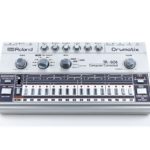 The Roland TR-606 Drumatix was a portable programmable analogue drum machine designed to tandem with the TB303 Bassline synth to provide solo artists with rhythm accompaniment. While the squelchy oddness of the TB303 later became synonymous with Acid House, the TR606 was almost dated by the time it was released, thanks to the advent of digital drum machines. It was used as a demo tool by acts like HEAVEN 17, while OMD were one of the few to use it in its own right on the ‘Dazzle Ships’ album.
The Roland TR-606 Drumatix was a portable programmable analogue drum machine designed to tandem with the TB303 Bassline synth to provide solo artists with rhythm accompaniment. While the squelchy oddness of the TB303 later became synonymous with Acid House, the TR606 was almost dated by the time it was released, thanks to the advent of digital drum machines. It was used as a demo tool by acts like HEAVEN 17, while OMD were one of the few to use it in its own right on the ‘Dazzle Ships’ album.
Iconic Example Of Use: OMD ‘Silent Running’
SIMMONS SDS-V (1981)
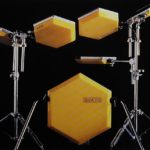 One of the first electronic percussion kits, it was designed by Dave Simmons and Richard James Burgess of LANDSCAPE. The electronics were based on the ARP 2600 synth and the material for the drum sets was similar to that used in police riot shields. Meanwhile, the shape was inspired by honeycomb. Its sound soon became characteristic of the era and drummers from all genres got in on using it. But the lack of give in the drum material caused physical problems for players due to the dead shock to the arms!
One of the first electronic percussion kits, it was designed by Dave Simmons and Richard James Burgess of LANDSCAPE. The electronics were based on the ARP 2600 synth and the material for the drum sets was similar to that used in police riot shields. Meanwhile, the shape was inspired by honeycomb. Its sound soon became characteristic of the era and drummers from all genres got in on using it. But the lack of give in the drum material caused physical problems for players due to the dead shock to the arms!
Iconic Example Of Use: TALK TALK ‘Today’
LINNDRUM (1982)
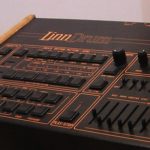 Officially known as the LM-2, the LinnDrum was an upgraded, more efficiently packaged version of the original LM-1 drum computer with added crash and ride cymbals which were not possible on the first machine due to restricted memory size of the integrated circuits used. It also had some innovative features for the time such as swing, quantizing and memory storage. It became the studio drum machine of choice for many including OMD, HEAVEN 17, GARY NUMAN, JOHN FOXX and ULTRAVOX.
Officially known as the LM-2, the LinnDrum was an upgraded, more efficiently packaged version of the original LM-1 drum computer with added crash and ride cymbals which were not possible on the first machine due to restricted memory size of the integrated circuits used. It also had some innovative features for the time such as swing, quantizing and memory storage. It became the studio drum machine of choice for many including OMD, HEAVEN 17, GARY NUMAN, JOHN FOXX and ULTRAVOX.
Iconic Example Of Use: HEAVEN 17 ‘Temptation’
E-MU SYSTEMS DRUMULATOR (1983)
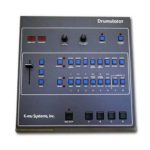 Following the success of their affordable Emulator sampler, E-MU Systems developed a programmable rhythm unit that featured 12 bit samples. At just $1000, it opened up digital drum sounds to many more musicians unwilling to shell out for a LinnDrum or DMX. Used by TEARS FOR FEARS on ‘Shout’ and DEPECHE MODE on their ‘Construction Time Again’ opus, it was also the first digital drum machine of choice for COCTEAU TWINS.
Following the success of their affordable Emulator sampler, E-MU Systems developed a programmable rhythm unit that featured 12 bit samples. At just $1000, it opened up digital drum sounds to many more musicians unwilling to shell out for a LinnDrum or DMX. Used by TEARS FOR FEARS on ‘Shout’ and DEPECHE MODE on their ‘Construction Time Again’ opus, it was also the first digital drum machine of choice for COCTEAU TWINS.
Iconic Example Of Use: DEPECHE MODE ‘Everything Counts’
ROLAND TR909 RHYTHM COMPOSER (1984)
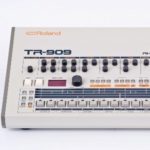 An analogue / sample hybrid drum machine with MIDI compatibility and editable analogue sounds, it was originally a poor seller on its release due to a hefty £1000 price tag for its apparently dated credentials. However, it was later picked up on by American dance DJs and is now considered to be the link between Detroit Techno and Chicago House with its recognisable kicks, hi-hats and snares plus tweakable attack, tone, tuning, decay, snap and accent functions.
An analogue / sample hybrid drum machine with MIDI compatibility and editable analogue sounds, it was originally a poor seller on its release due to a hefty £1000 price tag for its apparently dated credentials. However, it was later picked up on by American dance DJs and is now considered to be the link between Detroit Techno and Chicago House with its recognisable kicks, hi-hats and snares plus tweakable attack, tone, tuning, decay, snap and accent functions.
Iconic Example Of Use: INNER CITY ‘Big Fun’
SEQUENTIAL CIRCUITS DRUMTRAKS (1984)
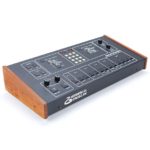 The Drumtraks was the first digital drum machine to feature the MIDI interface proposed by Sequential Circuits’ Dave Smith. But with a standard clock output as well, it was also compatible with older analogue synths. There were 13 sounds, each with programmable tuning and level control while editing was straightforward. It was used extensively by ULTRAVOX’s Warren Cann on the ‘Lament’ album and the standalone single ‘Loves Great Adventure’. Other users included PRINCE, GARY NUMAN and ORBITAL.
The Drumtraks was the first digital drum machine to feature the MIDI interface proposed by Sequential Circuits’ Dave Smith. But with a standard clock output as well, it was also compatible with older analogue synths. There were 13 sounds, each with programmable tuning and level control while editing was straightforward. It was used extensively by ULTRAVOX’s Warren Cann on the ‘Lament’ album and the standalone single ‘Loves Great Adventure’. Other users included PRINCE, GARY NUMAN and ORBITAL.
Iconic Example Of Use: ULTRAVOX ‘White China’
YAMAHA RX5 (1986)
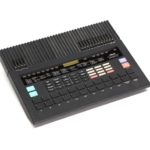 The RX5 was a versatile and affordable digital MIDI drum machine used by NEW ORDER and CAMEO. It had many editable parameters such as attack, decay, reverse and damp for each sound plus two levels of accent. The sounds could even be pitch-bent across several octaves while the bizarre time signatures that could be programmed ranged from 1/32 to 99/2! Also available were ROM Cartridges with further genre based percussive sets, while created sounds could be stored on RAM cartridges.
The RX5 was a versatile and affordable digital MIDI drum machine used by NEW ORDER and CAMEO. It had many editable parameters such as attack, decay, reverse and damp for each sound plus two levels of accent. The sounds could even be pitch-bent across several octaves while the bizarre time signatures that could be programmed ranged from 1/32 to 99/2! Also available were ROM Cartridges with further genre based percussive sets, while created sounds could be stored on RAM cartridges.
Iconic Example Of Use: NEW ORDER ‘Bizarre Love Triangle’
ALESIS HR16 (1987)
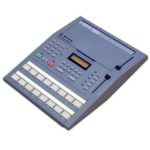 A 16 pad MIDI drum machine with 49 sounds including 10 kicks, 7 snares and a complete set of ethnic percussion which all came as 16 bit samples, this was a low-cost digital rhythm unit that survived an era when most producers were sampling live drumming performances into Akai S1000s. Patterns could be programmed in either step or real-time, while up to 16 drum tones could be used within a pattern. The key to its success was its value for money and it was used by ORBITAL, THE GRID and OMD.
A 16 pad MIDI drum machine with 49 sounds including 10 kicks, 7 snares and a complete set of ethnic percussion which all came as 16 bit samples, this was a low-cost digital rhythm unit that survived an era when most producers were sampling live drumming performances into Akai S1000s. Patterns could be programmed in either step or real-time, while up to 16 drum tones could be used within a pattern. The key to its success was its value for money and it was used by ORBITAL, THE GRID and OMD.
Iconic Example Of Use: OMD ‘Sailing On The Seven Seas’
Text by Chi Ming Lai
16th September 2014, updated 23rd October 2017

Follow Us!